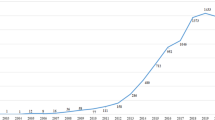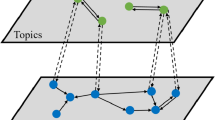Abstract
Online Social Networks (OSNs) such as Twitter, Facebook, Instagram, and WhatsApp are turned as a place for many of people in recent years to spend much of their time, due to their huge network structure and massive amounts of user-generated data in it. Those data’s are widely used in various real-world applications such as online marketing, epidemiology, digital marketing, online product or service promotion, and online recommendation systems. Presently, the twitter has grown to become a mainstream medium for the dissemination of messages, which creates necessitated intensive research challenges in the field of social influential gauging, Influence Maximization Problems, alongside an information diffusion. First, to address the social influential gauging a novel Topic Adaptive Sentiment Classification based Community Detection (TASCbCD) algorithm is proposed to detect communities in twitter network based on the results of topic based sentiment classification using robust topic features. In the topic modelling, the initial topics of each extracted data and the robust topic features were used to classify using a multi-class support vector machine. The WordNet and SentiWordNet are benchmark data sets that are used for supporting those classification to achieve the desired results. The resultant communities give a better visualization of identifying the overlapping communities that helps to gauge the topic based social influential user in OSNs. However, from the experimental result, it is observed that the proposed algorithm achieves better results in RandIndex and Scaled Density metrics than state-of-the-art methods for communities detection.

















Similar content being viewed by others
Data Availability Statement
The dataset underlying this article will be shared on reasonable request to the corresponding author through mail.
References
Ahajjam S, El Haddad M, Badir H (2016) Influentials identification for community detection in complex networks. In: 2016 4th IEEE International Colloquium on Information Science and Technology (CiSt). IEEE, pp 111–115
Arab M, Afsharchi M (2014) Community detection in social networks using hybrid merging of sub-communities. J Netw Comput Appl 40:73–84
Asur S, Parthasarathy S, Ucar D (2009) An event-based framework for characterizing the evolutionary behavior of interaction graphs. ACM Trans Knowl Discov Data (TKDD) 3(4):16
Baek J-W, Chung K-Y (2020) Multimedia recommendation using word2vec-based social relationship mining. Multimed Tools Appl:1–17
Banik A, Shamsi Z, Laiphrakpam DS (2019) An encryption scheme for securing multiple medical images. J Inf Secur Appl 49:102398
Baroi SJ, Singh N, Das R, Singh TD (2020) Nits-hinglish-sentimix at semeval-2020 task 9: Sentiment analysis for code-mixed social media text. arXiv:2007.12081
Capuano N, Chiclana F, Fujita H, Herrera-Viedma E, Loia V (2017) Fuzzy group decision making with incomplete information guided by social influence. IEEE Trans Fuzzy Syst 26(3):1704–1718
Capuano N, Chiclana F, Herrera-Viedma Ex, Fujita H, Loia V (2019) Fuzzy group decision making for influence-aware recommendations. Comput Hum Behav 101:371–379
Chang C-S, Lee D-S, Liou L-H, Lu S-M, Wu M-H (2018) A probabilistic framework for structural analysis and community detection in directed networks. IEEE/ACM Trans Netw (TON) 26(1):31–46
De Maio C, Fenza G, Gallo M, Loia V, Parente M (2018) Social media marketing through time-aware collaborative filtering. Concurr Comput Pract Exper 30(1):e4098
De Maio C, Fenza G, Gallo M, Loia V, Parente M (2019) Time-aware adaptive tweets ranking through deep learning. Futur Gener Comput Syst 93:924–932
Derbas N, Dusserre E, Padró M, Segond F (2018) Eventfully safapp: hybrid approach to event detection for social media mining. J Ambient Intell Human Comput:1–9
Dey P, Chatterjee A, Roy S (2018) Knowledge based community detection in online social network. In: 2018 10th International Conference on Communication Systems & Networks (COMSNETS). IEEE, pp 637–642
Di J, Wang X, He D, Lu W, Fogelman-Soulié F (2017) Jianwu Dang. Identification of generalized communities with semantics in networks with content. In: IEEE 29th International Conference on Tools with Artificial Intelligence (ICTAI). IEEE, pp 1182–1189
Dongen S (2000) Graph clustering by flow simulation [ph. d. dissertation]. Centers for Mathematics and Computer, Science. University of Utrecht
Dou K, Guo B, Li K (2019) A privacy-preserving multimedia recommendation in the context of social network based on weighted noise injection. Multimed Tools Appl 78(19):26907–26926
Fu W, Le S, Xing EP (2009) Dynamic mixed membership blockmodel for evolving networks. In: Proceedings of the 26th annual international conference on machine learning. ACM, pp 329–336
Guidi B, Michienzi A, De Salve A (2019) Community evaluation in facebook groups. Multimed Tools Appl:1–20
Hajarian M, Bastanfard A, Mohammadzadeh J, Khalilian M (2019) Snefl: Social network explicit fuzzy like dataset and its application for incel detection. Multimed Tools Appl 78(23):33457–33486
Hangal S, MacLean D, Lam MS, Heer J (2010) All friends are not equal: Using weights in social graphs to improve search. In: Workshop on Social Network Mining & Analysis, ACM KDD
Ji P, Zhang S, Zhou Z (2020) A decomposition-based ant colony optimization algorithm for the multi-objective community detection. J Ambient Intell Human Comput 11(1):173–188
Jia S, Gao L, Gao Y, Wang H (2014) Anti-triangle centrality-based community detection in complex networks. IET Syst Biol 8(3):116–125
Kumar A, Sangwan SR, Nayyar A (2019) Rumour veracity detection on twitter using particle swarm optimized shallow classifiers. Multimed Tools Appl 78(17):24083–24101
Kumaran P, Chitrakala S (2017) Social influence determination on big data streams in an online social network. Multimed Tools Appl 76(21):22133–22167
Laiphrakpam DS, Khumanthem MS (2017) Cryptanalysis of symmetric key image encryption using chaotic rossler system. Optik 135:200–209
Li W, Ye Z, Xin M, Jin Q (2017) Social recommendation based on trust and influence in sns environments. Multimed Tools Appl 76(9):11585–11602
Lin Y-R, Chi Y, Zhu S, Sundaram H, Tseng BL (2009) Analyzing communities and their evolutions in dynamic social networks. ACM Trans Knowl Discov Data (TKDD) 3(2):8
Liu L, Xu L, Wangy Z, Chen E (2015) Community detection based on structure and content: A content propagation perspective. In: 2015 IEEE International Conference on Data Mining. IEEE, pp 271–280
Liu T, Xue F, Sun J, Sun X (2019) A survey of event analysis and mining from social multimedia. Multimed Tools Appl:1–18
Liu Y, Niculescu-Mizil A, Gryc W (2009) Topic-link lda: joint models of topic and author community. In: Proceedings of the 26th annual international conference on machine learning. ACM, pp 665–672
Loia V, Parente D, Pedrycz W, Tomasiello S (2018) A granular functional network with delay: some dynamical properties and application to the sign prediction in social networks. Neurocomputing 321:61–71
Loia V, Tomasiello S, Vaccaro A, Gao J (2020) Using local learning with fuzzy transform: application to short term forecasting problems. Fuzzy Optim Decis Making 19(1):13–32
Lu Z, Sun X, Wen Y, Cao G, Porta TL (2014) Algorithms and applications for community detection in weighted networks. IEEE Trans Parallel Distrib Syst 26(11):2916–2926
Lv H, Tao L, Xianglin H, Hongxiao G, Zengfeng B (2017) Detection algorithm based on closeness rank and signal transimission. In: IEEE 2nd Advanced Information Technology, Electronic and Automation Control Conference (IAEAC). IEEE, pp 443–447
Meetei LS, Singh TD, Bandyopadhyay S (2019) Wat2019: English-hindi translation on hindi visual genome dataset. In: Proceedings of the 6th Workshop on Asian Translation, pp 181–188
Nesi P, Pantaleo G, Paoli I, Zaza I (2018) Assessing the retweet proneness of tweets: predictive models for retweeting. Multimed Tools Appl 77(20):26371–26396
Ouvrard X, Le Goff J-M, Marchand-Maillet S (2020) Exchange-based diffusion in hb-graphs. Multimed Tools Appl:1–36
Pang J, Huang J, Zhang W, Huang Q, Yin B (2017) Justify role of similarity diffusion process in cross-media topic ranking: an empirical evaluation. Multimed Tools Appl 76(23):25145–25157
Pattabiraman B, Md Mostofa AP, Gebremedhin AH, Liao W-k, Choudhary A (2015) Fast algorithms for the maximum clique problem on massive graphs with applications to overlapping community detection. Internet Math 11 (4-5):421–448
Plantié M, Crampes M (2013) Survey on social community detection. In: Social media retrieval. Springer, pp 65–85
Porcel C, Ching-López A, Lefranc G, Loia V, Herrera-Viedma E (2018) Sharing notes: an academic social network based on a personalized fuzzy linguistic recommender system. Eng Appl Artif Intell 75:1–10
Qi G-J, Aggarwal CC, Huang T (2012) Community detection with edge content in social media networks. In: 2012 IEEE 28Th International Conference on Data Engineering. IEEE, pp 534–545
Qi X, Tang W, Wu Y, Guo G, Fuller E, Zhang C-Q (2014) Optimal local community detection in social networks based on density drop of subgraphs. Pattern Recogn Lett 36:46–53
Rani S, Mehrotra M (2017) Hybrid influential centrality based label propagation algorithm for community detection. In: 2017 International Conference on Computing, Communication and Automation (ICCCA). IEEE, pp 11–16
Rathore S, Loia V, Park JH (2018) Spamspotter: an efficient spammer detection framework based on intelligent decision support system on facebook. Appl Soft Comput 67:920–932
Ruta M, Scioscia F, Pinto A, Gramegna F, Ieva S, Loseto G, Sciascio ED (2019) Coap-based collaborative sensor networks in the semantic web of things. J Ambient Intell Human Comput 10(7):2545–2562
Sachan M, Contractor D, Faruquie TA, Subramaniam LV (2012) Using content and interactions for discovering communities in social networks. In: Proceedings of the 21st international conference on World Wide Web. ACM, pp 331–340
Sani NS, Manthouri M, Farivar F (2020) A multi-objective ant colony optimization algorithm for community detection in complex networks. J Ambient Intell Human Comput 11(1):5–21
Shadang M, Saharia N, Singh TD (2020) Towards the study of morphological processing of the tangkhul language. arXiv:2006.16212
Singh TD Addressing some issues of data sparsity towards improving english-manipuri smt using morphological information. Monolingual Mach Transl:46
Singh TD, Solorio T (2017) Towards translating mixed-code comments from social media. In: International Conference on Computational Linguistics and Intelligent Text Processing. Springer, pp 457–468
Sun PG (2014) Weighting links based on edge centrality for community detection. Physica A: Stat Mech Appl 394:346–357
Swain AK, Balabantaray BK, Rout JK, Satpathy S An optimal deep learning approach for classification of age groups in social network
Tai C-H, Philip SY, Yang D-N, Chen M-S (2013) Structural diversity for resisting community identification in published social networks. IEEE Trans Knowl Data Eng 26(1):235–252
Tang L, Liu H, Zhang J, Nazeri Z (2008) Community evolution in dynamic multi-mode networks. In: Proceedings of the 14th ACM SIGKDD international conference on Knowledge discovery and data mining. ACM, pp 677–685
Wang C-D, Lai J-H, Philip SY (2013) Neiwalk: community discovery in dynamic content-based networks. IEEE Trans Knowl Data Eng 26(7):1734–1748
Wang C, Tang W, Wang Y, Fang J, Yao S (2017) Local community detection algorithm based on links and content. In: 2017 IEEE 2Nd Advanced Information Technology, Electronic and Automation Control Conference (IAEAC). IEEE, pp 1805–1808
Wang D, Long S (2019) Boosting the accuracy of differentially private in weighted social networks. Multimed Tools Appl 78(24):34801–34817
Wang X, Liu G, Li J (2017) Overlapping community detection based on structural centrality in complex networks. IEEE Access 5:25258–25269
Yang T, Jin R, Chi Y, Zhu S (2009) Combining link and content for community detection: a discriminative approach. In: Proceedings of the 15th ACM SIGKDD international conference on Knowledge discovery and data mining. ACM, pp 927–936
Yarow J (2010) Twitter finally reveals all its secret stats. Business Insider SAI
Zhou Y, Cheng H, Jeffrey Xu Y (2009) Graph clustering based on structural/attribute similarities. Proc VLDB Endowment 2(1):718–729
Zhuang K, Shen H, Zhang H (2017) User spread influence measurement in microblog. Multimed Tools Appl 76(3):3169–3185
Author information
Authors and Affiliations
Corresponding author
Additional information
Publisher’s note
Springer Nature remains neutral with regard to jurisdictional claims in published maps and institutional affiliations.
Appendix
Appendix
Rights and permissions
About this article
Cite this article
Kumaran, P., Chitrakala, S. Topic adaptive sentiment classification based community detection for social influential gauging in online social networks. Multimed Tools Appl 82, 8943–8982 (2023). https://doi.org/10.1007/s11042-021-11855-3
Received:
Revised:
Accepted:
Published:
Issue Date:
DOI: https://doi.org/10.1007/s11042-021-11855-3










